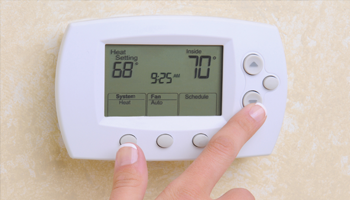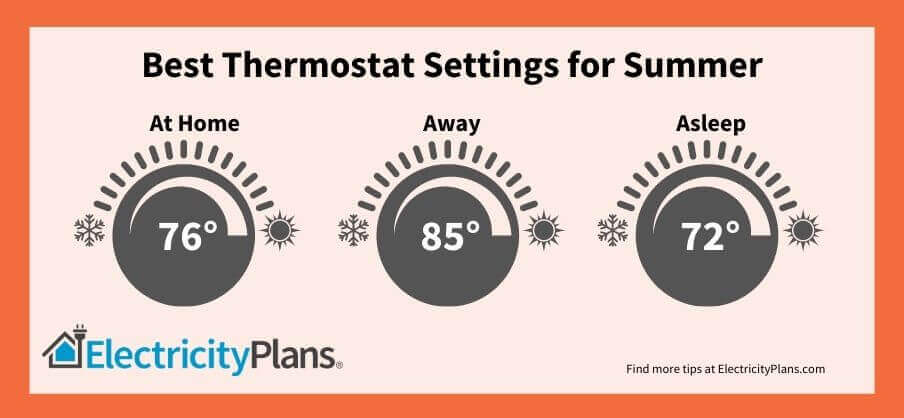Check Best Thermostat Pricing in Amazon
** As an Amazon Associate, I earn from qualifying purchases.
Finding the perfect thermostat setting in summer can be tricky. You want comfort without high energy bills.
Many people wonder what the ideal temperature is for their home during the hot months. Setting your thermostat correctly can save money and keep you cool. In summer, balancing comfort and cost is crucial. Your home should feel pleasant, but you don’t want to overspend on energy.
So, what’s the best temperature setting? This guide will help you find that sweet spot. Let’s explore the ideal thermostat settings to keep your home comfortable and your energy bill manageable.

Credit: northernclimatecontrol.com
Optimal Temperature Range
Finding the right thermostat setting can make summer more comfortable. It can also help save on energy bills. The optimal temperature range balances comfort and efficiency. Let’s explore the best settings for different times of the day.
Ideal Daytime Settings
During the day, aim for a thermostat setting of 78°F (26°C). This temperature keeps your home cool without overworking your air conditioner. If you feel warm, use fans to circulate air. Fans use less energy and can make a big difference.
Nighttime Adjustments
At night, you can set the thermostat a bit higher. A setting of 80°F (27°C) is often comfortable for sleeping. Open windows to let in cool night air if it’s safe. This can help keep your home cool and reduce AC use.
Energy Efficiency
Finding the right thermostat setting during summer can save energy. It also reduces cooling costs. Many people overlook the importance of their thermostat. Yet, it plays a crucial role in energy efficiency. Below, we will discuss two key aspects: saving on cooling costs and thermostat placement.
Saving On Cooling Costs
Adjusting your thermostat can lead to significant savings. Set it between 75 and 78 degrees Fahrenheit. Every degree higher can reduce cooling costs by 3-5%. Use fans to help circulate cool air. They allow you to set the thermostat higher without losing comfort. Close curtains or blinds during the day. This keeps the sun from heating up your home. Also, consider using a programmable thermostat. It adjusts settings automatically, saving energy when you are not home.
Thermostat Placement
The placement of your thermostat matters. Avoid placing it near heat sources. These include windows, lamps, or kitchen appliances. Heat sources can cause false readings. This makes your AC work harder. Install the thermostat on an interior wall. Ensure it is away from direct sunlight and drafts. These factors can affect its accuracy. The ideal height is about 5 feet above the floor. This ensures it reads the average air temperature. Proper placement optimizes energy efficiency. It helps maintain a comfortable home.
Smart Thermostats
Smart thermostats are more than just a fancy gadget for tech enthusiasts. They can significantly improve your comfort and energy efficiency during the summer. With the ability to learn your schedule and preferences, smart thermostats can ensure your home is always at the perfect temperature, without wasting energy.
Benefits Of Smart Technology
One of the biggest benefits of smart thermostats is their ability to save you money. By learning your habits and adjusting the temperature accordingly, they can reduce your energy bill without sacrificing comfort.
Another great feature is remote control. You can adjust the thermostat from your smartphone, whether you’re at work, on vacation, or just lounging in bed. This means no more coming home to a sweltering house on a hot day.
Smart thermostats also provide valuable insights into your energy usage. Many models offer detailed reports that can help you understand when and how you’re using the most energy, allowing you to make informed decisions about your habits.
Popular Smart Thermostat Models
There are several smart thermostats on the market, each with its own unique features. The Nest Learning Thermostat is a popular choice, known for its sleek design and learning capabilities. It can create a schedule based on your habits and adjust itself automatically.
The Ecobee SmartThermostat is another excellent option. It comes with a built-in Alexa and room sensors that help manage hot and cold spots in your home. This ensures consistent comfort throughout the house.
If you’re looking for something budget-friendly, the Honeywell Home T9 is worth considering. It offers many of the same features as the more expensive models, like remote control and energy reports, at a lower price point.
Have you ever thought about how much more comfortable your summer could be with a smart thermostat? Which model seems the best fit for your home and lifestyle?
Humidity Control
Humidity control is a key factor in summer comfort. High humidity can make your home feel warmer than it is. Controlling humidity helps maintain a comfortable indoor environment.
Role Of Humidity In Comfort
Humidity affects how we perceive temperature. High humidity levels can make the air feel hotter. This is because the moisture in the air prevents sweat from evaporating. Evaporation is how our bodies cool down. In a home with high humidity, the air feels sticky and warm. On the other hand, low humidity can make the air feel cooler but can dry out skin and nasal passages.
Using Dehumidifiers
Dehumidifiers help control indoor humidity levels. These devices remove excess moisture from the air. This makes the air feel cooler and more comfortable. Place dehumidifiers in rooms with high humidity levels. Basements and bathrooms are common areas that benefit from dehumidifiers. Regularly empty the water tank to keep the dehumidifier running efficiently. Choose a dehumidifier that fits the size of the room for best results.
Personal Comfort
Finding the perfect thermostat setting in summer can be tricky. Personal comfort varies from person to person. Everyone has a different threshold for heat and cold. Setting the thermostat to a temperature that everyone finds comfortable is key. This balance ensures you stay cool without overworking your AC.
Adjusting For Activities
Different activities may require different temperatures. For example, cooking in the kitchen can make the room hotter. In such cases, lowering the thermostat by a few degrees can help. On the other hand, if you are reading or watching TV, a slightly higher setting might be fine. Adjust the thermostat based on what you are doing. This keeps you comfortable and can save energy.
Family Preferences
Every family member might have their own comfort zone. Kids might feel colder than adults. Older family members might prefer it warmer. Talk to everyone about their preferences. Find a middle ground that suits all. If needed, use fans or blankets for individual comfort. This way, everyone feels good without constant thermostat changes.

Credit: tindallranson.com
Check Best Thermostat Pricing in Amazon
** As an Amazon Associate, I earn from qualifying purchases.
Insulation Tips
As temperatures rise in summer, maintaining a cool home without breaking the bank can be a challenge. A well-insulated house can make a significant difference in keeping your thermostat settings efficient. Here are some practical insulation tips to help you stay cool and save on energy bills.
Improving Home Insulation
One of the first steps is to improve your home’s insulation. Proper insulation keeps the cool air inside and the hot air outside. Check your attic, walls, and basement for any insulation gaps.
Use fiberglass or foam insulation in your attic. This helps reduce the heat that enters your home. If you’re unsure where to start, consider consulting a professional to assess your insulation needs.
A friend of mine recently added insulation to his attic. He noticed a significant drop in his energy bills and a more comfortable indoor temperature. This simple step can have a big impact on your cooling efficiency.
Weather Stripping
Weather stripping is another effective way to improve insulation. It seals gaps around doors and windows, preventing cool air from escaping and hot air from entering.
Check for gaps around your doors and windows. If you find any, use adhesive-backed foam or rubber weather stripping to seal them. This small investment can lead to significant savings on your energy bills.
Last summer, I added weather stripping to my front door. It made a noticeable difference in keeping my home cooler without constantly adjusting the thermostat. Plus, it was easy to install and didn’t take much time.
How do you plan to improve your home’s insulation this summer? Share your thoughts and experiences in the comments below!
Ceiling Fans
Ceiling fans are a valuable tool for managing your home’s temperature in the summer. They help distribute air more evenly, making rooms feel cooler. Using ceiling fans correctly can save energy and reduce your reliance on air conditioning.
Enhancing Air Circulation
Ceiling fans enhance air circulation by pushing cool air down. This creates a breeze that makes you feel cooler. Even if the air isn’t cooler, the moving air helps evaporate sweat, cooling your skin.
Place ceiling fans in the rooms you use most. This includes living rooms, bedrooms, and kitchens. Use ceiling fans along with your air conditioning system. This allows you to set the thermostat higher without feeling hot.
Fan Direction Settings
Setting your fan’s direction is important. In summer, set the fan to spin counterclockwise. This pushes air down, creating a cooling breeze. Stand under the fan to check the direction. You should feel a breeze directly below.
Many ceiling fans have a switch to change the direction. Usually, this switch is located on the fan’s motor housing. Check your fan’s manual if you are unsure. Set the fan to the correct direction to maximize cooling.
Vacation Settings
Heading out for a summer vacation? Don’t forget to adjust your thermostat. Properly setting your thermostat can save energy and lower your utility bills. It’s an easy step with significant benefits.
Temperature For Empty Homes
When no one is home, set the thermostat higher. Aim for 85 degrees Fahrenheit. This prevents the AC from running unnecessarily. It keeps energy use low while protecting your home from extreme heat.
Smart Thermostat Programs
Smart thermostats can make vacation settings simple. Program them to adjust temperatures automatically. Many smart thermostats have vacation modes. Use these to optimize energy savings. You can control these devices remotely. This means you can adjust the settings anytime. Even if you’re miles away.

Credit: jacobsheating.com
Frequently Asked Questions
Is 72 A Good Temperature For Air Conditioning?
Yes, 72 degrees is a good temperature for air conditioning. It provides comfort and energy efficiency for most people.
Is 78 Too Hot For A House?
78 degrees can be comfortable for many people. It helps save energy and reduce cooling costs. Adjust based on personal preference.
Is 72 Too High For Thermostat In Summer?
Setting your thermostat to 72°F in summer is generally comfortable. Energy experts recommend 78°F for optimal efficiency.
What Is The Best Setting For Thermostat In Summer?
Set your thermostat to 78°F (26°C) for optimal comfort and energy savings during summer. Adjust slightly for personal preference.
Conclusion
Setting the thermostat correctly in summer saves energy and money. A comfortable range is 78 degrees Fahrenheit. This setting balances comfort and efficiency. Adjust the temperature higher when you’re away. Use fans to enhance cooling. Maintain your HVAC system for optimal performance.
Experiment to find what works best for you. Remember, every degree matters. Small changes make a big difference. Enjoy a cool and cost-effective summer with these simple tips.
Check Best Thermostat Pricing in Amazon
** As an Amazon Associate, I earn from qualifying purchases.


